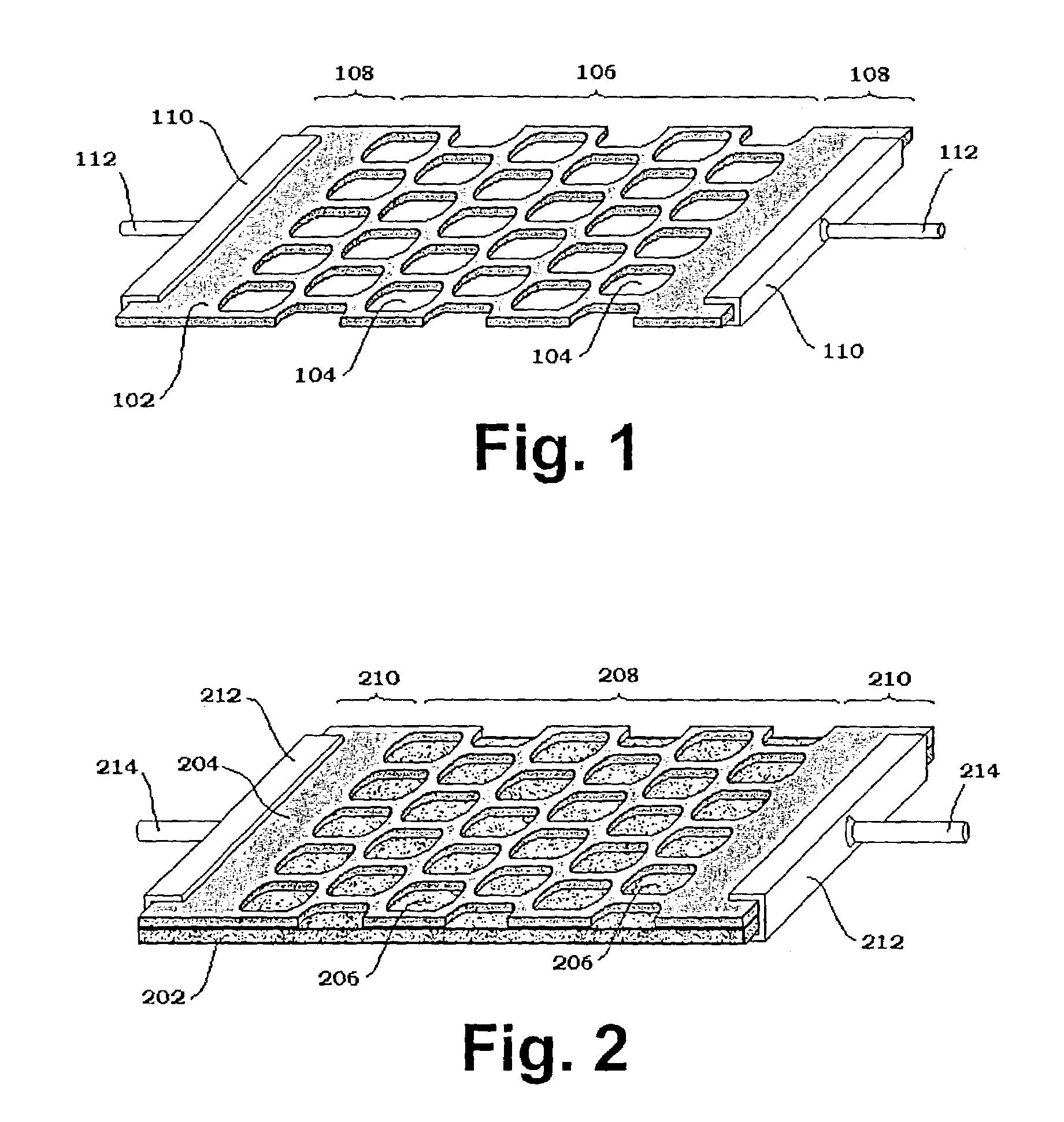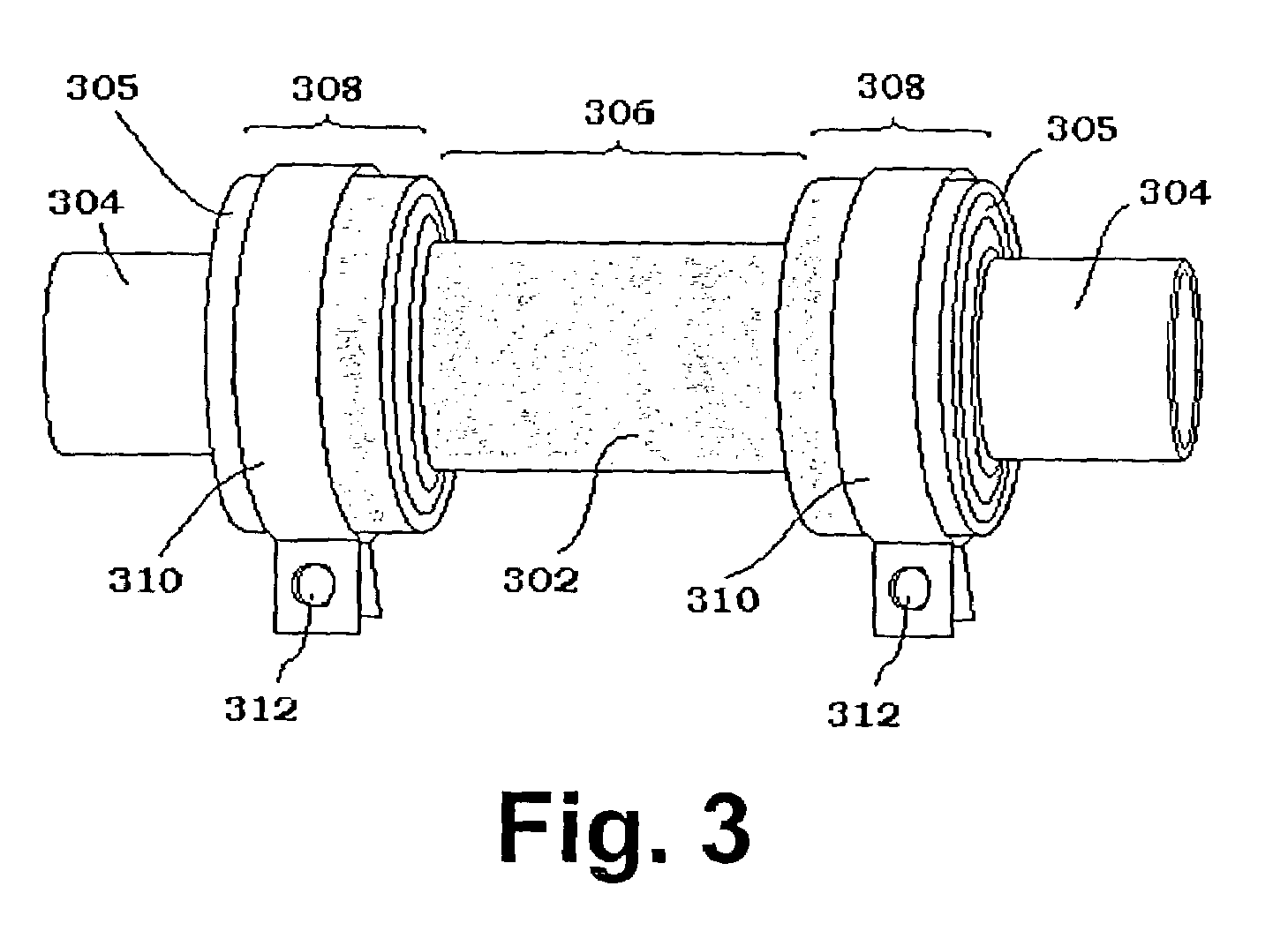Another significant
disadvantage is that deposition rates are relatively slow, and thicker films will require excessively long times to fabricate using typical CVD processes.
The operational and safety precautions that must be used with CVD techniques are often very expensive,
time consuming and cumbersome.
Process sequences are constrained and limited by the lowest
maximum temperature tolerance of any other device or layer on the substrate being processed.
While it is possible to create small (<100 micrometers), fast reacting heating elements with micro-
machining techniques, it is also well known that these processes are time and labor-intensive, and require very large capital and operational expenditures.
In general, widespread usage has been limited by the cost of complicated micro-fabrication processes, use temperature restrictions, and wet chemical
processing requirements.
Tubular shaped elements have the added complications and expense of requiring apparatus to rotate the element during deposition or
sputtering of the conductive material onto the tubular substrate.
“Thick” and “thin” film resistive heating elements have many inherent disadvantages that generally limit their usefulness and applicability.
One problem with the film deposition processes is that voids or pinholes can be formed in the film materials during
sequential deposition or printing and firing steps.
Another more serious
disadvantage is that the requirement for building up many multiple film
layers in order to create more durable or complex element features results in an expensive process due to the increased time and number of individual process steps that are involved.
Yet another common problem with “thick” and “thin” film heating elements is that they allow only a relatively low surface-specific
heating power (usually less than 2.34–3.10 W / cm2), and only relatively low radiant surface temperatures (usually less than 500–600 C maximum).
A particular disadvantage of printable conductors in the form pastes and inks is that the materials tend to be very expensive.
Metallization systems such as Pd / Ag, that are most commonly used to print resistive heating films can cost $500.00 or more for quantities as small as 50 grams, making anything but relatively thin films (that is less than about 50 micrometers) impractical from the cost standpoint alone.
A disadvantage inherent with screen printable inks and pastes is that they often require multiple print, dry, and sinter cycles to build-up sufficient thickness for applications that require
higher power and
heat transfer capabilities.
These disadvantageous multiple cycles increase the manufacturing costs.
For example, the substrate beneath the isolating layer is generally etched away so that a suspended membrane is formed upon which the heater element is located, thereby increasing the
thermal isolation of the heater element, which results in a significant decrease in
power consumption.
As is well known to those skilled in the art, one of the most challenging and persistent problems with “green” or pre-fused
ceramic tapes and multilayer lamination technologies has been devising practical methods to successfully eliminate slumping or deformation of suspended or laminated structures during the high temperature
sintering process.
Also, serious deformation can occur when stacks of green ceramic tapes are laminated under even relatively low pressures to form monoliths containing structures like channels or cavities, particularly when these structures have high aspect ratios.
All of the previously developed anti-sagging techniques appear to be limited in their usefulness and success.
For example, the tensile force that the bridging thick film exerts must be carefully balanced with the force that is inducing the sagging of the suspended layer, and the extra complication of depositing a thick film adds time, and expense to the process.
Also, lead bi-
silicate frits and other sacrificial materials often leave a residue that requires
etching in
hydrofluoric acid (HF) or other undesirable processes that may damage structures to remove the residue.
Finally, the fugitive carbon pastes and most other
solvent-based pastes are susceptible to
drying, shrinking,
cracking or deforming, multiple pastes
layers are desired to build up sufficient thickness for many applications, and the pastes are inconvenient to apply in a rapid precise manner, all of which increases the desired time, labor and overall fabrication costs.
Many important resistive heater applications exist for materials that can operate at temperatures greater than about 500 C in air or corrosive atmospheres for prolonged times. Under some circumstances it may be possible to deposit thick films of
refractory metals such as W, Mo, Ta, Pt and Pd deposited on high-temperature
ceramic materials such as aluminum
oxide or
zirconium oxide, however nearly all metals (including W, Mo, and Ta) are unsuitable for use in air or corrosive atmospheres because they degrade rapidly (oxidize or corrode) at higher temperatures, and the
inert Pt group metals (Pt, Ir, Rh, Re, Pd) are all prohibitively expensive.
Another major disadvantage that is common to nearly all metal-based heating elements (including
platinum group metals) is that the intrinsic
bulk resistivity of metals is far too low, (usually less than 1 milliohm·cm), to achieve high power densities and surface temperatures.
Unfortunately, the durability and
power handling capability decrease rapidly as the cross sectional area of the metallic conductor decreases, and defects (such as a void or variations in the thickness) become more critical.
Oxidized metals tend to be brittle, and the oxidized layer may not be adherent to the underlying material, leading to
mechanical failure.
Unfortunately, the electro-conductive ceramic igniters tend to be mechanically fragile and fracture easily due to the fact that SiC (and nearly all other monolithic
ceramic materials) are very brittle, and stress is concentrated at the sharp bends in the unsupported “hairpin” design of the igniters and heating elements.
Although SiC, MoSi2, and related
carbide and
silicide ceramics have many of the properties that make them near ideal for high temperature reisitive heating applications, they are difficult to process and it is impractical or nearly impossible to produce shapes that are more complex than simple cylinders and plates without expensive
diamond machining and
grinding operations.
Dense ceramic carbides, borides and silicides typically require expensive or exotic
process equipment including hot isostatic presses (HIP), capable of reaching temperatures of 1700 C and pressures of 30,000 psi or more under
inert or evacuated atmospheres.
The HIP process is energy intensive and
time consuming, and is therefore not economical or practical for high volume production applications or where more complex shapes are desired.
Most known panel heating elements, including the
Denim invention, provide a relatively low surface-specific
heating power and only relatively low heating temperatures, and they are relatively expensive labor intensive processes that require multiple printing,
drying, and
sintering stages.
The
porosity that is generated in
combustion synthesized (SHS) products continues to be the most uncontrollable and serious disadvantage.
Due to a lack of control over the pressure-less SHS process, the products have a tendency to develop non-homogeneous phase distributions.
For heating elements, the non-uniformities in the products lead to destructive localized overheating in areas where the non-uniformities exist.
It is clear that components and materials produced with the pressure-less SHS process have degraded properties, and can be characterized as mechanically weak and fragile.
Although much prior work has centered on developing techniques to eliminate
porosity in
combustion synthesized (SHS) materials, success has only been achieved in a very limited number of cases.
Combustion synthesis processes are rapid by nature, and the time for simultaneous
sintering is too short to be of value.
External force or pressure is difficult to apply in most situations involving
combustion, and the application of pressure limits this method to use with simple shapes like cylinders, and to situations where die damage is not a problem.
Unfortunately, most often the
liquid phase does not wet the products, or the volume of the liquid may not be enough to fill the pores and the
residence time of the hot liquid may be too short to fill the pores in time.
Other deposition technologies include arc
plasma or
flame spraying methods that utilize a very expensive, high-energy beam
machine capable of producing ceramic coatings on suitable substrates.
The
plasma sprayed ceramic coatings are brittle and tend to have a high degree of undesirable as-sprayed
porosity.
Also, the process is not well suited for the fabrication of precision miniaturized “meso-scale” devices.
 Login to View More
Login to View More 


